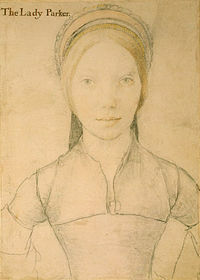Born Jane Parker, a distant relative of Henry VIII, she became a lady-in-waiting to his first wife, Catherine of Aragon, and to quite a few of those that followed. Married Anne Boleyn’s brother, George, and later, when Anne was an unwanted wife and George and Anne were accused of incest, Jane gave evidence against her husband. Consequently George was beheaded on Tower Hill along with four other men also accused of adultery with Anne. A few years later when Henry needed to get rid of another wife, Anne of Cleves, Jane again provided useful evidence. When Catherine Howard (number 5) needed a go-between to facilitate her liaisons with Thomas Culpeper Jane stepped into the role. But the affair was discovered and all involved and some that weren't, were imprisoned. Jane appeared to suffer a nervous breakdown and was declared insane which ought to have saved her life but Henry changed the law to allow the execution of the insane and so Jane was beheaded at Tower Green, immediately after Catherine.
This section lists the memorials where the subject on this page is commemorated:
Jane Boleyn, Viscountess Rochford
Commemorated ati
Tower of London execution site
Catling wrote the poem as well as creating the sculpture. Doesn't that cushio...
Other Subjects
Robert Smith
Protestant martyr. Before his execution,he wrote to his wife Anne: “Grace, mercy and peace from God the Father and from the Lord Jesus Christ be with you dear wife, now and for ever, amen, and prev...
Ensign Eliane Sophie Plewman, Croix de Guerre
Elaine Sophie Browne-Bartroli was born on 6 December 1917 in Marseille, France, the daughter of Eugene Henry Browne and Elsa Francesca Browne née Bartroli. In addition to the information shown on ...
125 deaths on Tower Hill
Wikipedia lists only 36 (in 2011). Most of the victims that we have researched are recorded as having been beheaded but A London Inheritance, quoting John Stow (c. 1598), refers to "a large scaffo...
Rosa Luxemburg
Revolutionary socialist. Born Rozalia Luksenburg, she was a Polish and naturalised-German orthodox Marxist, and anti-War activist during WW1. She became a key figure of the revolutionary socialist ...
Person, Execution, Politics & Administration, Tragedy, Germany, Poland, Russia
Earl of Kilmarnock
Jacobite. Taken prisoner at the Battle of Culloden. Tried and beheaded on the Tower Hill scaffold.








Comments are provided by Facebook, please ensure you are signed in here to see them